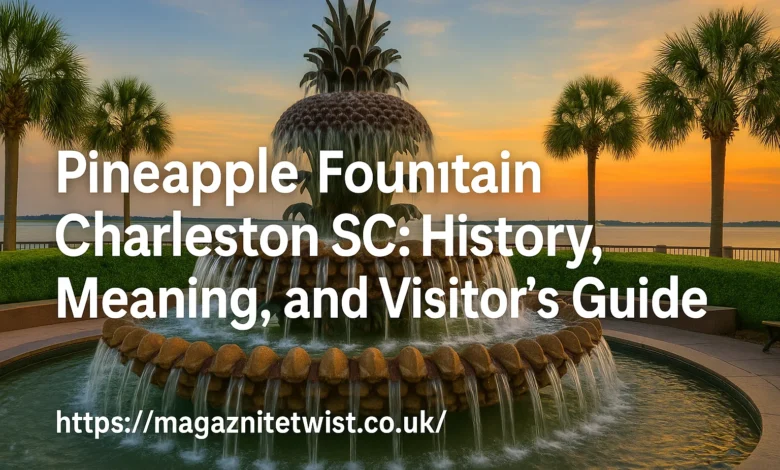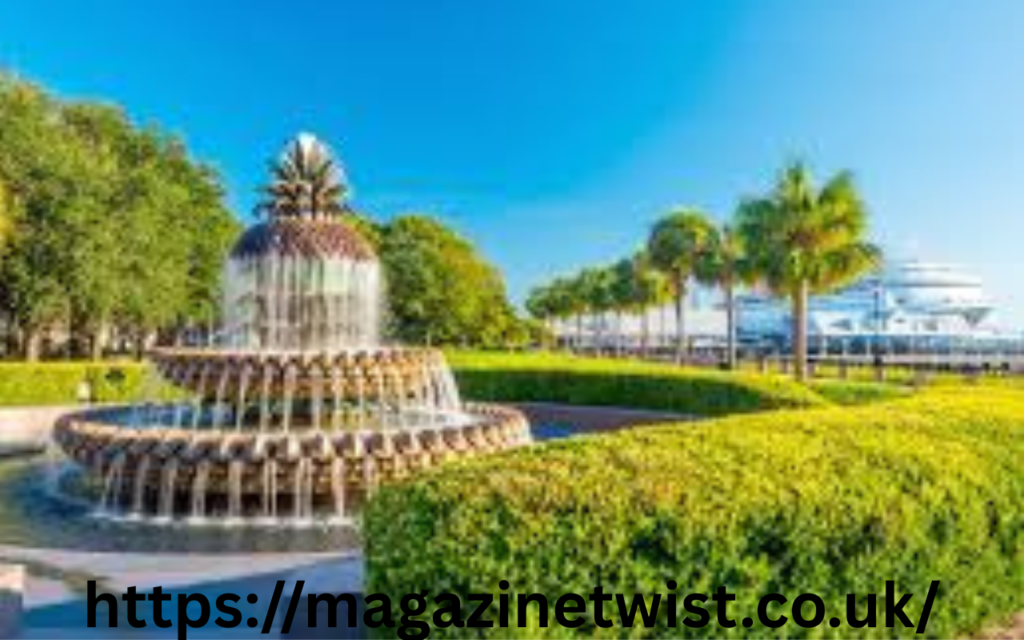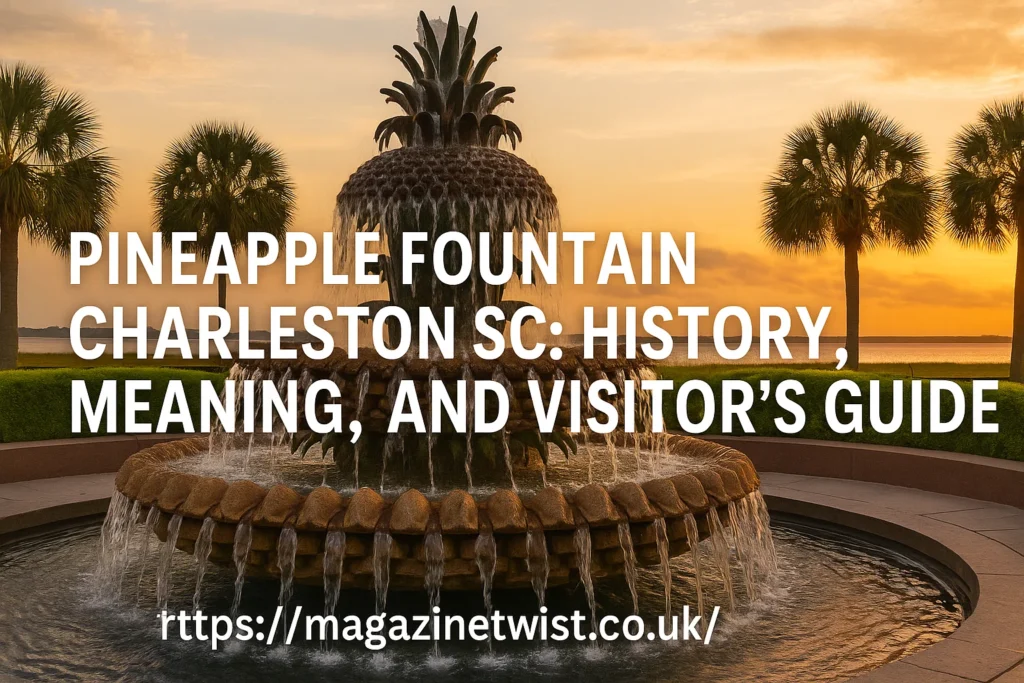Pineapple Fountain Charleston SC: History, Meaning, and Visitor’s Guide

Pineapple Fountain Located in the heart of Charleston’s Waterfront Park, the Pineapple Fountain is more than just a beautiful landmark—it’s a powerful symbol of Southern hospitality, a tribute to resilience, and a favorite gathering spot for locals and tourists alike. Whether you’re a history buff, a travel enthusiast, or simply someone seeking the charm of Charleston, this comprehensive guide will give you a deeper understanding of the Pineapple Fountain—from its symbolic roots to practical tips for your visit.
The Historical Roots of the Pineapple Fountain
The origins of the Pineapple Fountain are tied directly to the revitalization of Charleston’s waterfront. In the late 20th century, the area where Waterfront Park now thrives was an underused and neglected industrial site. Once dominated by shipping terminals and warehouses, the space became an eyesore after a fire in the 1950s damaged the wharves beyond repair.

The city of Charleston decided in the 1980s to transform this decaying area into a public space for recreation and community. Led by mayor Joseph P. Riley Jr., this vision gave birth to Waterfront Park, which opened in 1990 after nearly a decade of planning, fundraising, and construction delays—including setbacks caused by the devastating Hurricane Hugo in 1989.
When the park finally opened, the Pineapple Fountain stood proudly as its center piece. Designed to embody the spirit of welcome, its installation represented not only the rebirth of the waterfront but also Charleston’s resilience in the face of adversity.
Why the Pineapple? A Symbol of Southern Hospitality
The use of the pineapple as a central theme is no accident. Historically, the pineapple has long been associated with hospitality in Charleston and throughout the American South. During the colonial era, pineapples were rare and exotic. Sailors and sea captains returning from the Caribbean would sometimes spear a pineapple on their gatepost to signal that they were home and ready to welcome guests.
As such, the pineapple evolved into a powerful symbol of warmth, welcome, and generosity—traits that Charleston takes pride in. Today, you’ll find pineapples all across the city—carved into doorways, featured on wrought-iron gates, and, of course, forming the dramatic shape of one of Charleston’s most beloved fountains.
Design and Structure of the Pineapple Fountain
Visually, the Pineapple Fountain is stunning. It features a tiered structure shaped like a pineapple, with water cascading gently down each layer. Its size and placement are impressive yet calming—inviting visitors not just to observe but to engage with it.
Designed by landscape architects Stuart Dawson and his team at Sasaki Associates, the fountain stands about 12 feet high and is constructed of bronze and concrete. The textured layers mimic the rough exterior of a real pineapple, while the surrounding shallow pool invites visitors—especially children—to dip their toes or even wade in on a hot summer day.
The fountain is beautifully lit in the evenings, casting soft reflections across the pool and adding a romantic ambiance to Charleston’s already picturesque setting.
The Role of the Fountain in Waterfront Park
The Pineapple Fountain isn’t just a standalone attraction—it’s part of a larger and very thoughtfully designed park. Waterfront Park spans eight acres along the Charleston Harbor and includes tree-lined walking paths, large grassy areas, flower gardens, bench swings facing the water, and another splash fountain on the southern end.
The park was created as a space for relaxation and community connection. Whether you’re strolling with a loved one, enjoying a picnic, or watching ships roll into the harbor, the Pineapple Fountain serves as a perfect backdrop for many of life’s small moments. For many Charleston residents, it’s not just a tourist spot—it’s part of the daily rhythm of the city.
Visiting the Pineapple Fountain: What to Know
If you’re planning a visit to Charleston, stopping by the Pineapple Fountain is a must. Here are some practical tips to help you make the most of your experience:
- Location: Waterfront Park, Concord Street, Charleston, SC 29401
- Cost: Free to visit
- Hours: Open 24 hours a day
- Best Time to Visit: Early morning or evening for fewer crowds and beautiful lighting
You don’t need tickets or reservations to visit the park or the fountain, and it’s conveniently located within walking distance of the Historic Charleston City Market and Rainbow Row.
Photography enthusiasts will want to visit during the golden hour—either just after sunrise or before sunset—to capture the fountain with soft, natural lighting. And if you’re traveling with kids, bring a towel—they’ll likely end up splashing in the water!
Cultural and Community Significance
For locals, the Pineapple Fountain is more than a tourist attraction—it’s a place of gathering, celebration, and pride. Whether it’s being used as a backdrop for engagement photos, wedding shoots, or local events, the fountain carries strong emotional resonance for Charleston residents.
Throughout the year, you’ll see people lounging on the benches nearby, walking their dogs, or simply enjoying the coastal breeze. It’s a symbol that brings people together, fostering a sense of community that echoes Charleston’s values of kindness and hospitality.
Moreover, the Pineapple Fountain often appears in promotional materials, postcards, and artwork that represent Charleston to the world. It’s become one of the city’s most photographed and instantly recognizable landmarks—second only to perhaps Rainbow Row or the Battery.
Maintenance and Preservation Efforts
With thousands of visitors each year, the Pineapple Fountain requires regular upkeep to ensure it remains in pristine condition. The city of Charleston has a dedicated team responsible for maintaining Waterfront Park’s fountains, landscaping, and walkways.
Periodic restoration efforts have included cleaning, repainting, and technical work to keep the water system functioning efficiently. These efforts are part of a broader initiative to preserve Charleston’s historical and cultural landmarks, ensuring that future generations can enjoy them just as much as we do today.
Nearby Attractions to Explore
The Pineapple Fountain is situated in one of the most walkable areas of Charleston, making it easy to build a half-day or full-day itinerary around your visit. Here are some nearby attractions worth exploring:
- Charleston City Market: Just a few blocks away, this historic market features local vendors, handmade crafts, and delicious Lowcountry cuisine.
- Rainbow Row: This iconic stretch of pastel-colored homes along East Bay Street is one of the most photographed spots in the city.
- The Battery and White Point Garden: A scenic waterfront promenade lined with historic mansions and cannons from the Civil War era.
- Historic Churches and Buildings: Charleston is filled with well-preserved architecture, including churches dating back to the 1700s.
You can easily spend an entire day wandering the streets of downtown Charleston, with the Pineapple Fountain as your central landmark and starting point.
Family-Friendly and Pet-Friendly Destination
One of the great aspects of Waterfront Park is that it’s suitable for visitors of all ages. Kids love playing in the splash fountain or wading in the Pineapple Fountain, while adults enjoy the peaceful surroundings and photo opportunities. Even your four-legged friends are welcome—just make sure they’re on a leash and that you clean up after them.
Benches, shaded paths, and open lawns make it a comfortable place for a picnic or midday rest, especially in the warmer months. There’s also plenty of space to enjoy without feeling crowded, even during tourist season.
Tips for a Great Visit
Here are a few quick tips to enhance your experience:
- Stay hydrated: Bring a water bottle, especially during hot months.
- Arrive early: Mornings are less crowded and perfect for peaceful reflection or photography.
- Check the weather: The fountain is outdoors, so check the forecast before planning your day.
- Bring a camera or phone: You’ll want to capture the beauty of the fountain and the views of the harbor.
- Wear comfortable shoes: Downtown Charleston is best explored on foot.
Conclusion: Why the Pineapple Fountain Is a Charleston Must-See

The Pineapple Fountain is more than just a pretty sight—it’s a deep reflection of Charleston’s spirit, values, and community pride. From its rich historical symbolism to its role as a local gathering place, this fountain embodies everything that makes Charleston special.
Whether you’re enjoying a romantic evening stroll, introducing your kids to a splash of fun, or capturing that perfect Instagram shot, the Pineapple Fountain offers something meaningful to every visitor. It’s a place where past meets present, where beauty meets purpose, and where hospitality is always in full flow.



